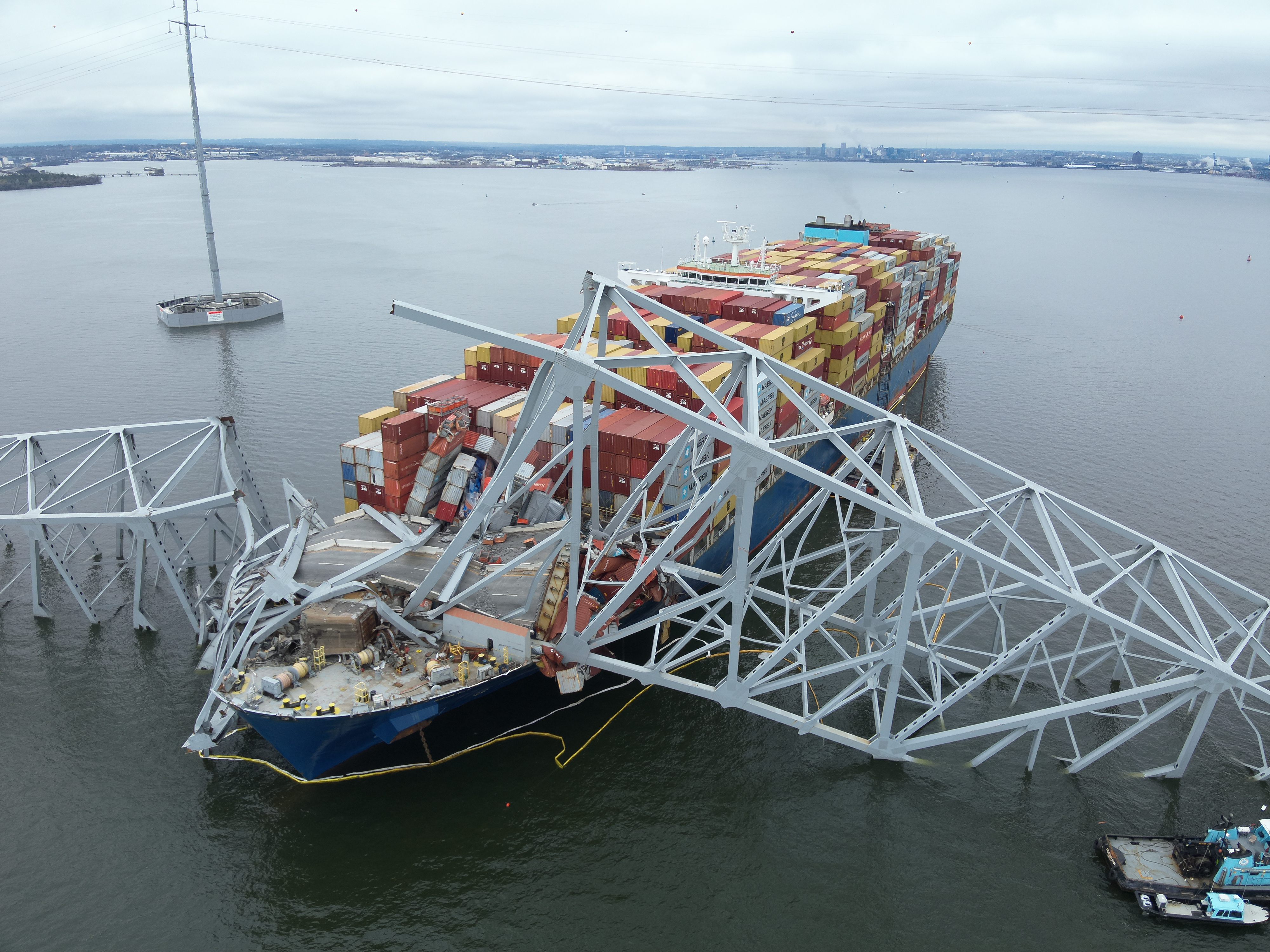
In the early hours of March 26, 2024, a container ship allided with the Francis Scott Key Bridge in Baltimore, Maryland, causing the structure to collapse into the Patapsco River and triggering a local, state, and federal response. The incident was the result of the container ship M/V Dali losing propulsion and steering when transiting outbound from Baltimore Harbor, resulting in damage to the bridge, the vessel and its contents, and most tragically, the loss of six construction workers’ lives.
Immediately after the collapse of the bridge, the U.S. Coast Guard (USCG) notified the NOAA Scientific Support Coordinator (SSC) within the Office of Response and Restoration (OR&R) to initiate NOAA’s support for the incident. After notification, OR&R’s Disaster Preparedness Program activated the National Ocean Service (NOS) Incident Management Team (IMT) to collect information and enhance coordination and response efforts directly supporting the federal response.
The NOAA Scientific Support Coordinator reported on-scene to the incident command post to establish a NOAA presence and continue coordination of support. Concurrently, OR&R emergency response specialists gathered vital information on the vessel and its cargo to determine the potential hazards from any releases.
Initial Pollution Assessment and Monitoring
At the time of allision, the M/V Dali had 1.5 million gallons of fuel on board. The allision caused M/V Dali to lose four shipping containers and 14 of the 56 HAZMAT containers onboard were crushed or damaged. Although no immediate reports observed fuel oil being released from the vessel, as a precaution and to mitigate observed sheens, hard boom lined with sorbent boom were deployed around the vessel, except where marine debris prevented access. Reported and observed sheens were believed to be hydraulic oil from the vessel’s bow thruster, small amounts of diesel from various trucks and equipment casualties related to the incident. OR&R chemists assessed and characterized the vessel’s cargo for hazardous materials, identifying no immediate pollution threats to operations.
Preparing For A “Worst Case” Release

OR&R continued to prepare worst case scenario oil spill trajectories, at the request of the USCG, for the 1.5 million gallons of fuel that remained on board the M/V Dali. Trajectories examined potential impacts if a worst case discharge of heavy fuel oil were to occur from the vessel due to stress on the vessel or associated with salvage operations. USCG Sector Maryland Incident Management Division submitted an emergency Endangered Species Act consultation on March 26, updated on March 30, to identify resources at risk if any pollution concerns arose. An environmental unit stood up in the Incident Command Post comprised of Maryland Department of the Environment, EPA, OR&R, USCG District 5 District Response Advisory Team, and Community Relations managers developed a pollution mitigation plan that provided mitigation measures for steady state and high-risk salvage operations based on NOAA Environmental Sensitivity Index (ESI) maps.
In total, OR&R produced 15 trajectory analyses, five chemistry reports, 14 situational updates, and 12 IMT situation reports to support pollution operations over the course of 62 days during the Key Bridge Response.
Given the evolving theme of strong navigation services during the response, OR&R transitioned its NOAA leadership role within the response’s Incident Command Post to the Office of Coast Survey on March 30. IMT leadership remained available to help broker additional NOAA products, services, and support.
Salvors working with the Key Bridge Response Unified Command refloated and moved the M/V Dali on May 20. The Unified Command continued to clear wreckage from the bottom of the Patapsco River. Eleven weeks after the bridge’s collapse, the U.S. Army Corps of Engineers and U.S. Navy Supervisor of Salvage and Diving, as part of the Unified Command response, restored the Fort McHenry Federal Channel on June 10 to its original operational dimensions of 700 feet wide and 50 feet deep.
Incident Coordination Within and Outside of NOS
The NOS IMT is composed of members from each NOS program office and headquarters who serve as key points of contact for incident coordination during disasters and other events. Many NOS and NOAA program offices acted under their own authorities to execute operations to respond to the Francis Scott Key Bridge collapse; OR&R convened daily meetings with IMT members to coordinate, improve awareness of the activities NOS engaged in, and distilled this information into reports for NOS and the NOAA Homeland Security Program Office. OR&R collaborated with at least 25 different internal and external partners to connect the needed expertise, skills, and tools to responders during the incident’s emergency and transition to recovery.
